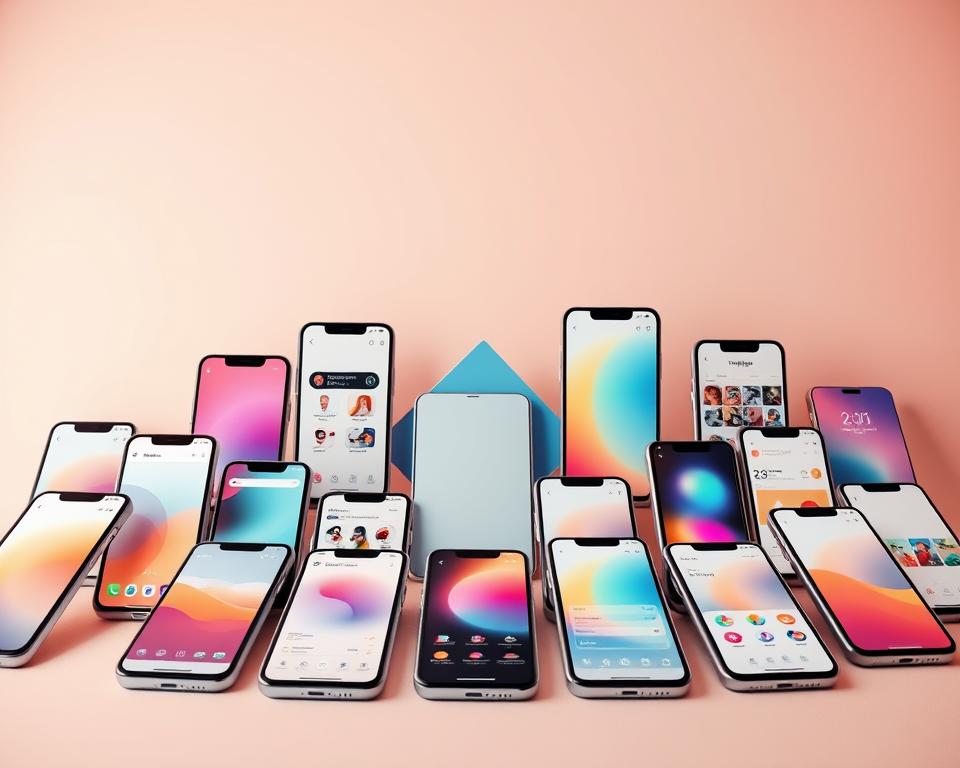Anuncios
Have you ever wondered why so many apps get downloads but few keep users? The market now has millions of listings, and downloads hit record levels in 2024. Yet day-30 retention sits near 2–4% and most people abandon apps inside three months. This guide frames practical, data-backed moves you can test to change that.
In 2025, the discovery squeeze and attention scarcity force a new playbook. You will learn how to balance website SEO, app store presence, social channels, influencers, and paid UA to reach the right people. The focus shifts from vanity downloads to meaningful engagement and long-term growth.
Expect clear benchmarks, simple diagnostics, and ethical marketing moves that prioritize onboarding, personalization, push cadence, content value, and in-app support. Test, measure, and verify sources before you adapt any tactic. Responsible exploration will help you keep users and scale in the U.S. and beyond.
Introducción
Users are harder to win in 2025 because millions of listings fight for every tap. The market contains roughly 3.5M Android and 2.2M iOS apps, so attention is scarce and costly.
Why 2025 matters: discovery has tightened, day-by-day drop-offs grew, and average 30-day retention sits near 5.7%. Many users stop engaging after the first month, making early value and ongoing engagement essential.
What you’ll get: practical, data-backed moves you can test, measure, and iterate without risky shortcuts. This guide focuses on aligning acquisition with retention so both fuel growth together.
- Operate with an experimentation mindset: test small UX changes and messaging before big bets.
- Monitor day retention and user behavior to spot churn points quickly.
- Prioritize features that respect time and privacy while delivering clear benefits.
APP’s strategies: the 2025 landscape in one view
Driving downloads is easy; turning those installs into active users is the real test. Your priority should be to lift engagement, improve retention, and grow lifetime value. Start with a simple model that treats acquisition and product as one funnel.
Blend channels, don’t bank on one. Combine organic content (SEO and blog), measured paid UA, social/influencer outreach, and product-led loops. Each channel must feed real value, not just cheap installs.
From installs to impact
Specify the key events that show real value: first meaningful action, week-one return, and a paid or habitual conversion. Track active users, DAU/MAU stickiness, session length, and feature adoption to judge health.
Balancing channels and the product
- Align creative, product, and analytics so everyone optimizes for the same outcomes.
- Test small UX and messaging changes often; ship fast to learn faster with limited downside.
- Benchmark by category—entertainment sessions run longer—then iterate toward your own best rates.
Watch for false wins. Short spikes in engagement can mask low long-term retention. Use ethical, data-informed tests to ensure growth brings real value to both you and your users.
What changed in discovery: SEO, your website, and app store optimization working together
Search and store visibility work best when your site and listing share clear, helpful signals. That means using keyword research to answer real questions, not stuffing pages with repeat terms.
Your app’s website and blog
Use tools like Semrush or Ahrefs to find intent-rich topics. Build helpful content that answers user questions and shows value.
Don’t cram keywords into headings or copy. Keyword stuffing lowers rankings and frustrates readers. Instead, use the blog to capture related search results and amplify via social and guest posts.
Landing page essentials
Your landing page should give users clarity fast. Include:
- Visuals: screenshots, short trailer video, and a clear hero image.
- Short copy: one-line benefit, two quick bullets, and a direct CTA.
- Social proof: ratings, reviews, awards, and press logos.
- Store links: visible buttons to each app store and a clear install action.
ASO updates that matter
Match website topics to store keywords for cohesive discovery across search results and listings.
Pick a keyworded title, test secondary categories, localize descriptions and visuals, and include videos and screenshots. Test hero copy and imagery to see which combo drives higher click-through and install action.
- Map web topics to store keywords for cleaner signals.
- Localize both web content and store pages for target regions.
- Pick secondary categories to broaden how users find your app.
- Keep pages fast, scannable, and mobile-first.
Social, influencer, and paid UA shifts you can use today
Social channels now double as listening posts and community rooms for your app, not just ad space. Users spend about 2.5 hours daily on social, so use that time to learn, not only to push promos.
Social as community and feedback
Host short discussions, polls, and help threads that let you hear how users feel. Share quick how-tos and behind-the-scenes posts to invite replies.
Focus on two-way conversations: they reveal behavior and preferences you can act on fast.
Influencer fit over reach
Pick creators whose values match your customer base. Authentic endorsements matter—86% of consumers say it influences purchase choices.
Give simple briefs and creative guardrails, then let creators adapt to maintain value and trust.
Paid UA with clear measurement
Define personas and the key in-app events you track before spending money. Use an attribution partner to link creatives and channels to real growth.
- Test formats: UGC, tutorials, and community challenges.
- Measure cohorts and reallocate quickly by observed behavior.
- Start small with CTV or new placements and set clear success criteria.
Retention is the new growth: benchmarks, friction fixes, and value moments
Keeping users long enough to show value is the single most cost-effective lever you have. Acquiring a new install can cost up to five times more than keeping an existing user. So your job is to lower churn and raise perceived value in the first week.
Why it matters
Low retention rates mean you must buy growth constantly. Improving user retention reduces dependence on heavy spend and improves long-term growth.
Benchmarks to watch
Track these baseline rates and compare to your category: iOS Day 1 ~28%, Day 7 ~13%, Day 21 ~8%, Day 30 ~7%. Overall 30-day averages sit around 5.7%, with Android often lower.
Practical retention plays
Map the onboarding funnel and spot the biggest drop-offs—sign-in, permissions, or unclear value are common culprits.
- Cohort by source: compare installs by creative and marketing channel to find higher-quality users.
- Fix early friction: reduce taps, delay nonessential permissions, and show clear first-session wins.
- Target high-value users: prioritize lifecycle messages and offers for cohorts that drive revenue or engagement.
- Trigger moments: send timely nudges when users are likely to stall—first task, day-3 check-in, or trial end.
Test every change, measure cohorts, and track retention rates, feature adoption, and direct feedback to iterate. Small fixes in the first day and first week often yield the biggest returns.
Personalization, push notifications, and fresh content that keeps users engaged
Delivering value within the first minute is the single best way to hold attention and earn trust. Your onboarding should show what the app does, not ask for everything upfront. Let people try a key action before account creation, like a sample lesson or quick setup flow.
Onboarding that shows value fast
Keep the sequence short and interactive so users see benefits quickly. Use one clear goal, a single CTA, and an optional skip path.
Ejemplo: let people complete a micro-task in the first minute to make the app feel useful right away.
Personalized experiences users welcome
Only use data users provide and tell them how it improves their experience. When people control preferences, they feel safer and engage more.
69% of users prefer personalization built on data they shared. Respecting privacy builds trust and long-term growth.
Push that helps, not annoys
Use timely nudges tied to goals or milestones. Start slow, ask for opt-in, and let people set frequency.
Customized notifications can raise response rates by up to 400% versus generic ones. Measure opt-in and open rates to tune messaging.
Regular updates and feature flags
Ship behind feature flags to test changes with small cohorts. Roll out progressively to limit risk and learn from real user behavior.
In-app support that keeps users in flow
Offer instant, in-app help and clear self-serve answers. About half of users prefer quick chat or bot help for immediate issues.
Keep support phrasing friendly, brief, and actionable so users return to the core experience fast.
- Onboarding: short, interactive, benefit-led.
- Personalization: based on provided data and clear opt-in.
- Push: relevant timing, user-set frequency.
- Releases: use feature flags for safe learning.
- Support: fast, in-app help and self-serve guidance.
The gamification comeback: proven mechanics that lift engagement in 2025
Smart game elements can nudge users back into your app and make routines feel rewarding. Gamification is a tool, not a cure-all. Use it to highlight real value and reduce churn, not to mask weak core flows.
Why it works
Psychology matters: good mechanics tap competence, autonomy, and relatedness. Variable rewards add anticipation and prompt return visits. Studies show gamification can lift retention by about 22% when tied to real goals.
Effective mechanics to try first
- Streaks and progress bars: clear signals of momentum.
- Challenges and limited-time events: spark social energy without long-term complexity.
- Badges and unlocks: reward meaningful actions, not vanity taps.
Practical guidance
Start with one element—streaks or a single progress bar—and measure day and day-30 engagement closely. Personalize difficulty so tasks feel achievable for each user. Use community challenges in learning, productivity, and fitness to show cross-vertical value.
Warning: avoid overlapping systems that confuse users. Tie rewards to product value and track changes in engagement and retention before you scale.
Measure what matters: engagement metrics, A/B testing, and feedback loops
Start by measuring a small set of clear signals that tie directly to your goals. Pick metrics that match your category and business model so you avoid chasing vanity numbers.
Core metrics to track
Focus on retention, churn, DAU/MAU (stickiness), session length, and feature adoption. These tell you whether your app creates lasting value.
Set targets by category—entertainment sessions run longer, news shows different DAU share—and watch rates over cohorts, not just totals.
A/B testing to validate changes
Run small tests on onboarding flows, thumbnails, and copy before you scale. Netflix-style thumbnail tests and controlled UX experiments reveal real behavior shifts.
Tie each test to a clear success threshold and measure impact on active users and retention, not just clicks.
Gather feedback from multiple channels
Use in-app surveys, ratings prompts, lightweight widgets, shake-to-send, and chatbots to hear from silent segments and vocal customers alike.
Combine quantitative and qualitative inputs so you can link a rate change to why users act the way they do.
Communities and loyalty that reinforce growth
Build forums, reward meaningful participation, and run loyalty programs that boost user retention. Communities can raise retention significantly when they create belonging.
Practical checklist:
- Define a core metric set and targets.
- Use A/B testing for UX and creative choices.
- Collect feedback from at least three channels.
- Track feature adoption and link to retention.
- Tie experiments to clear goals and thresholds.
Performance, accessibility, and going global: remove barriers to growth
A fast, simple experience is often the single biggest retention win. Slow load times and tangled navigation make users drop out before they see value. Focus on measurable gains that protect privacy and respect device limits.

Speed and reliability
Prioritize a speed budget and add performance checks to every release. Optimize code, compress assets, and lazy-load media so the app starts quickly on real devices.
Consejo: consider a lightweight mode for constrained networks, like Facebook Lite did, to reduce abandonment.
Design for clarity
Simplify flows so people finish tasks with fewer taps. Use consistent patterns and clear labels so a new user learns the interface in moments.
Offline access and localization
Cache critical data and offer offline access for key features, as Google Maps does for travel. Localize not just strings but help content and cultural cues to fit each market.
- Ensure readable contrast and larger touch targets for accessibility.
- Validate that localization respects regional privacy norms.
- Link performance and accessibility work to completion rates and retention.
Conclusión
Finish strong by making choices that respect users and build steady growth.
Take a user-first view across discovery, onboarding, and engagement to lift real value and improve return rates. Small, measured experiments tell you what works without risking trust.
Keep the app’s core promise clear, ship simple content and gentle game mechanics that help people form habits. Track the right rate and watch cohorts so you see which users engaged and why.
Before you scale: verify tools and marketing choices against trusted sources and your own data. Build for long-term growth, not short spikes, so users feel respected and return.



